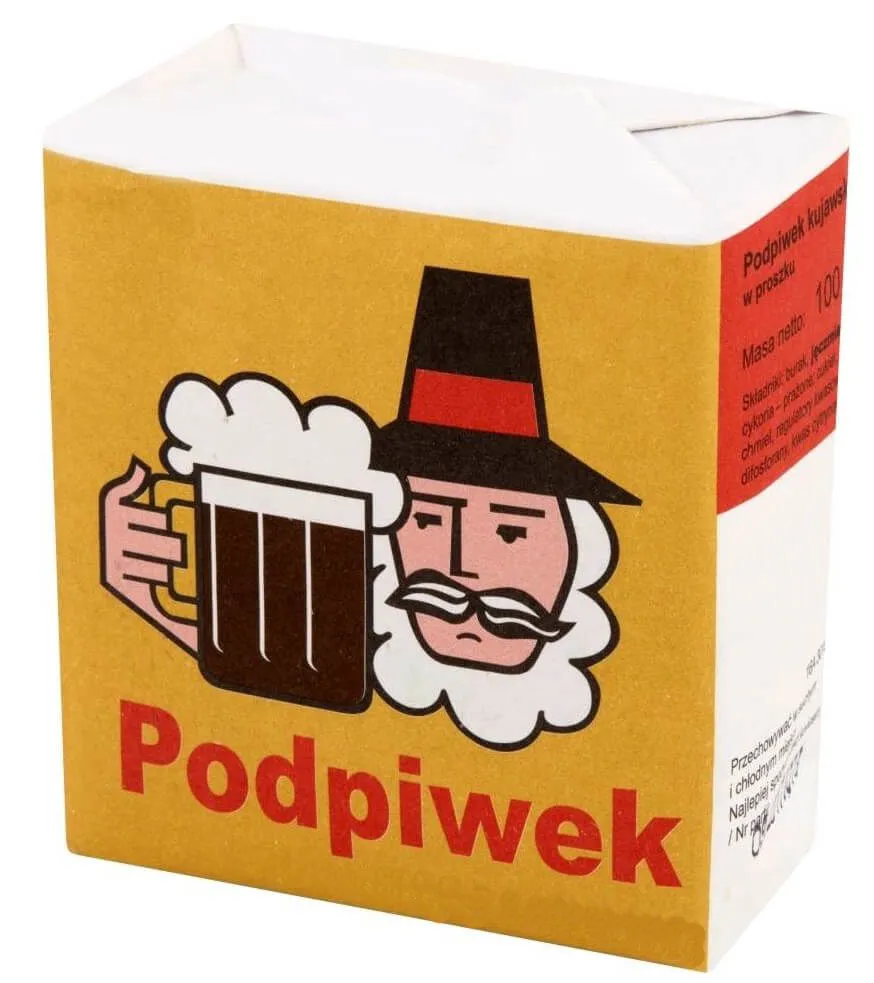Every now and then in a convenience store (and easily online) in Poland, you can find a genuinely vintage-looking gem: a paper-wrapped package, the size of a matchbox ten-pack, with a dwarf-looking cartoon guy in a folk hat holding a large mug of foamy beer.
If you do happen upon it, give it a try. The depicted mug content is not beer, but its traditional soft equivalent, known as podpiwek, which can be translated literally, perhaps oddly at first, as ‘underbeer’. The package contains a dry concentrated mixture to which water is added to make the soft drink.
Podpiwek – back in fashion
Priced at less than a euro for a ten-liter starter and with highly eco-friendly packaging – it’s hard to call it an alternative to Coke, which in early 2023 costs more than a euro for a half-liter bottle partly because of a sugar tax introduced in Poland to fight childhood obesity and diabetes. But why is it so deliciously vintage and peculiarly called anyway? Because it’s a traditional malt drink, now perhaps forgotten but still remembered in by similarly vintage-aged people. Contrary to some malt drinks made as beer from malted grain, this one is made from malt flour.
That means that dry grain, usually barley, is soaked in warm water until it sprouts. When grain germinates, it becomes sweeter as the plant automatically creates more easily digestible substances to nourish the process. But then the grain is dried again – and in this case, milled into flour, the base for podpiwek.
Beer, in its most simple form, is just water, barley, and yeast. And podpiwek is not much different, with barley flour instead of the grain itself. But, as with beers in the past – it contains very little alcohol, typically less than one percent. On a practical note – sometimes you have to buy yeast separately. The mix may contain some more sugar for the yeast to digest and perhaps some hops.
You combine the ingredients, ferment for three to five days – and voilà! Of course, it may be easier to buy (and more widely available) a ready-made bottle of ‘underbeer’ (note the price difference!) from soft-drink makers and breweries, the former being mass-produced, the latter perhaps more on the artisanal side.
“Underbeer” and its relatives
Podpiwek is dark, naturally foamy, and should have a deep, bittersweet taste. If you want to aim at a more sour taste, try going for kvass or “bread acid,” the refreshment made from toasted bread leftovers popular in the east.

For those who remember it, it is considered a socialist-style refreshment – perhaps to some extent to the way it is being packaged and sold, with the guy depicted on the label resembling socialist cartoon imagery.
But, as you can expect, its history is much longer. It is considered traditional to Poland and Lithuania and may originate from when both countries were components of the Polish-Lithuanian Commonwealth. The two countries share part of their culinary, and especially alcohol-making tradition (note barrel-aged vodka called Starka).
After all, brewing beer was a tradition and, to some extent, necessary to prepare a fresh and healthy drink considered purified compared to pure water. And with breweries located in manors, there were leftovers (traditional zero waste yet again!) that could be milled and turned into a refreshing drink. Hence the name ‘podpiwek‘ – the ‘underbeer’ was originally perhaps the ‘afterbeer’. Its first commercial production began in the mid-19th century.
And socialist Poland, in fact, added (or sustained – the 19th century was no rose garden either) one other tradition – adulterating ingredients by adding coffee, or if that wasn’t available – chicory.
But this doesn’t make us crave it as it remains a taste of childhood, or, in the case of younger people – the childhood of their forefathers. Hey, bread kvass – we’re waiting for a similar great comeback the podpiwek deserves!
Heading Central Europe? Why drink Coke – with the vast palette of alternatives. Learn more about Czech(oslovakian) soft drink Kofola that is a best-seller in Czechia to this day. Or, its Polish counterpart Polo-Cockta, famously used to ridicule communism in the late 1980s comedy movie. Try also kvass – the traditional beverage that used to dominate the east of the region, made from recycled stale bread. And be sure to subscribe to our newsletter to stay tuned with more food and beverage options (and more!)







